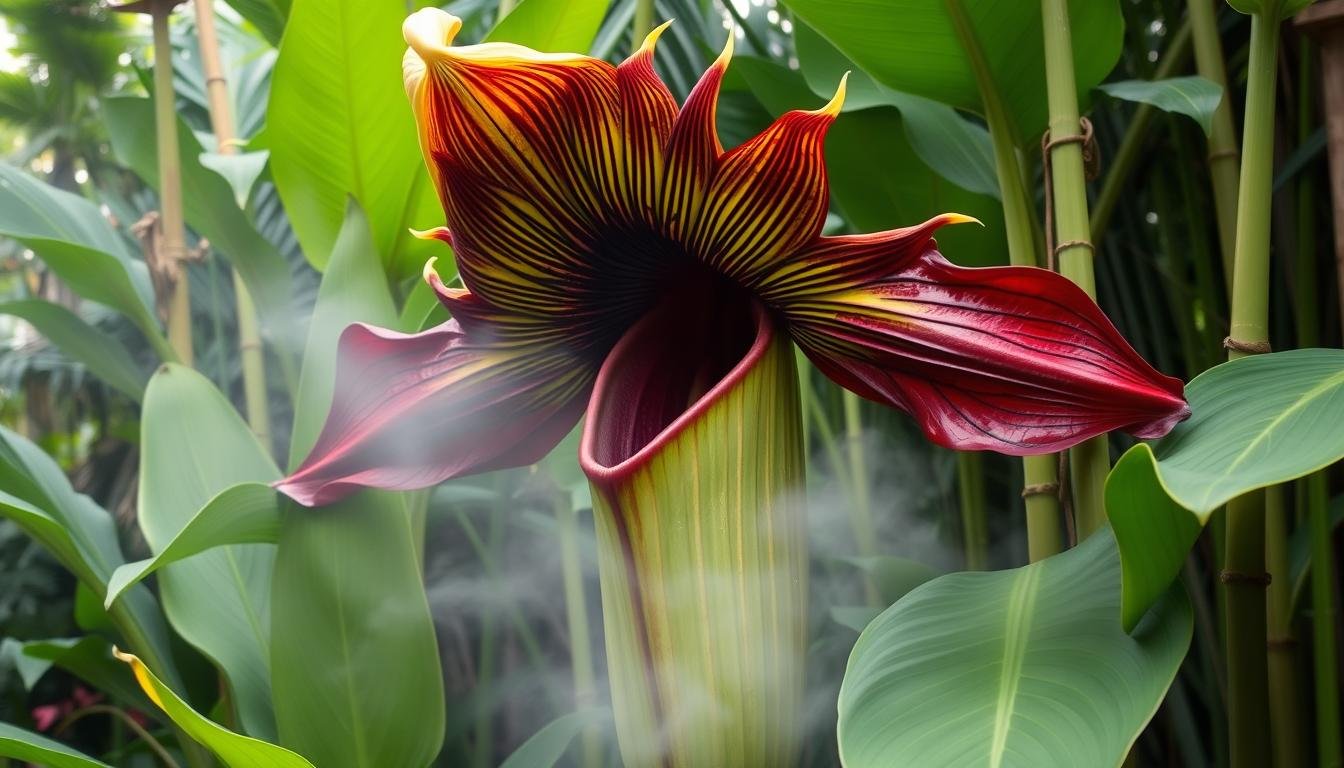Get ready to be amazed by the world’s most incredible and smelly plant – the corpse flower (Amorphophallus titanum). This giant can grow up to 8 feet tall. It’s even taller in the wild, with the biggest unbranched flower in the plant world.
The corpse flower’s charm is its strong smell, like rotting flesh. It attracts flies and beetles to pollinate it, helping the plant survive and reproduce in Sumatra’s tropical rainforests.
This plant blooms rarely, every 2-3 years. When it does, it’s a short but stunning show, lasting 2-3 days. Despite its size and smell, the Amorphophallus titanum is rare and endangered. Seeing it bloom is a special event.
Introduction to the Corpse Flower: Nature’s Remarkable Giant
Get ready to be amazed by the titan arum, the “corpse flower.” This rare plant comes from Sumatra. It’s famous for its strong smell, like rotting meat, which attracts insects for pollination.
The titan arum’s flower is truly impressive. It can grow up to 3 meters tall, the tallest unbranched flower in the world. In 2010, a titan arum named “New Reekie” at Edinburgh’s Royal Botanic Gardens had a corm (underground stem) that weighed 153.9 kg, the heaviest ever recorded.
The titan arum blooms only every few years. It opens for just 24-48 hours. During this time, it releases its unique smell to attract insects like beetles and flies for pollination. The flower then collapses quickly, making reproduction a short chance.
Despite its size and unique features, the titan arum is endangered. Its home in Sumatra is being destroyed. Places like Edinburgh’s Royal Botanic Gardens and Kew Gardens are working hard to save this plant.
The Fascinating Life Cycle of the World’s Largest Unbranched Inflorescence
The corpse flower, also known as the titan arum, is a captivating plant. It shows a remarkable life cycle. This giant grows from a massive underground stem called a corm. The corm stores energy over the years, fueling the plant’s eventual bloom.
Growth and Development Stages
It can take the corpse flower up to 10 years to bloom for the first time. It slowly accumulates the necessary energy in its corm. Once ready, the plant grows rapidly, increasing in height by several inches each day leading up to the bloom.
Blooming Pattern and Frequency
The blooming cycle of the corpse flower is highly unpredictable. It can range from a few years to over a decade between flowerings. When the plant is ready to bloom, it generates significant heat. This heat helps disperse its notorious odour and attract pollinators, primarily carrion beetles and flies.
Size and Physical Characteristics
The inflorescence of the titan arum can reach more than 3 meters (9.8 feet) in height. This makes it the world’s largest unbranched inflorescence. The bloom typically lasts 24-48 hours. The strongest smell occurs at night, coinciding with the peak pollination period.
After the brief but spectacular bloom, the plant may not die. Instead, it returns to its energy-storing phase. It awaits the next opportunity to showcase its remarkable floral display.
Understanding the Plant That Smells Like Rotting Meat
The corpse flower, also known as the titan arum (Amorphophallus titanum), is famous for its strong smell. It smells like cheese, rotten meat, fish, and decaying onions. This smell is how the plant attracts flies and beetles to pollinate it.
The smell of the corpse flower is strongest right after it blooms. It releases its scent at night when insects are most active. The plant also gets hot, helping the smell travel further. Some people find the smell too much, but others notice a sweet hint in it. The smell can stay on clothes for days.
The smell of the corpse flower comes from chemicals like dimethyl disulfide and trimethylamine. These chemicals make it smell like rotten meat and fish. The plant releases a lot of these chemicals to attract flies and beetles.
“The stench of the corpse flower changes from funky cheese to a ‘dead rat’ smell over time.”
As the bloom gets older, the smell changes. It goes from smelling like cheese to smelling like rotting flesh. This change helps the plant attract dung beetles, which are important for its reproduction.
The corpse flower’s pollination strategy is amazing. Its size and life cycle make it fascinating. Studying this plant helps us understand how it thrives in Sumatran rainforests.
Conservation Status and Natural Habitat
The corpse flower, also known as the titan arum, is a rare plant from Western Sumatra, Indonesia. It’s listed as “Endangered” on the IUCN Red List. Sadly, there are fewer than 1,000 of them left in the wild.
Native Environment in Sumatra
The corpse flower loves the humid rainforests of Sumatra. It grows from a huge underground corm that can be up to 220 pounds. But, its home is being destroyed by deforestation and oil palm plantations.
Current Population Status
The corpse flower’s numbers are dropping fast. There are now less than 1,000 in the wild. The IUCN says it’s at a very high risk of extinction.
Conservation Efforts Worldwide
Conservation efforts are underway to save the corpse flower. Places like the U.S. Botanic Garden are working hard. They’re trying to keep the plant’s genetic diversity alive. This way, they hope to ensure its survival for future generations.
FAQ
What is the corpse flower (Amorphophallus titanum)?
The corpse flower is the largest unbranched plant part, growing up to 8 feet tall. In the wild, it can reach 12 feet. It smells like rotting flesh to attract pollinators.
How often does the corpse flower bloom?
The corpse flower blooms every two to three years. It blooms for only 2-3 days.
Where is the corpse flower native?
It comes from Sumatra’s tropical rainforests in Indonesia. It was first found by science in 1878.
Has the U.S. Botanic Garden displayed the corpse flower?
Yes, the U.S. Botanic Garden has shown corpse flowers since 2003. Thousands of visitors come to see it.
What is the titan arum, and where has it bloomed?
The titan arum, also known as the corpse flower, is from Sumatra. It’s famous for its strong smell like rotting meat. It has bloomed five times at Edinburgh’s Royal Botanic Gardens, with the latest bloom reaching 8.7ft tall.
How large can the corpse flower’s underground structure get?
The plant’s underground part called a corm, can weigh over 150kg. It’s one of the largest ever recorded.
How long does it take for the corpse flower to bloom for the first time?
It can take up to 10 years for the plant to bloom for the first time.
How does the corpse flower’s blooming cycle work?
The blooming cycle is unpredictable, lasting from a few years to over a decade. When ready, the plant grows fast, increasing in height daily.
What happens during the corpse flower’s bloom?
The inflorescence heats up to spread its strong odour. The bloom lasts 24-48 hours, with the smell strongest at night.
What does the corpse flower’s smell resemble?
Its smell is like a mix of cheese, rotten meat, fish, and decaying onions.
Why does the corpse flower have such a strong odour?
The smell is to mimic rotting flesh. It attracts carrion-eating insects like flies and beetles for pollination.
What is the conservation status of the corpse flower?
The corpse flower is listed as Endangered by the IUCN. There are fewer than 1,000 in the wild. Its population has dropped by over 50% in 150 years due to logging and habitat loss.
What conservation efforts are in place for the corpse flower?
Efforts include keeping it in botanic gardens worldwide. The U.S. Botanic Garden is part of a project to save its genetic diversity. They aim to ensure new offspring have a mix of genes through cross-pollination.



